
19.06.2021
The curator Diego Ventura Puac-Coyoy shares some ideas about the curatorial positioning articulated by the 22nd Bienal de Arte Paiz
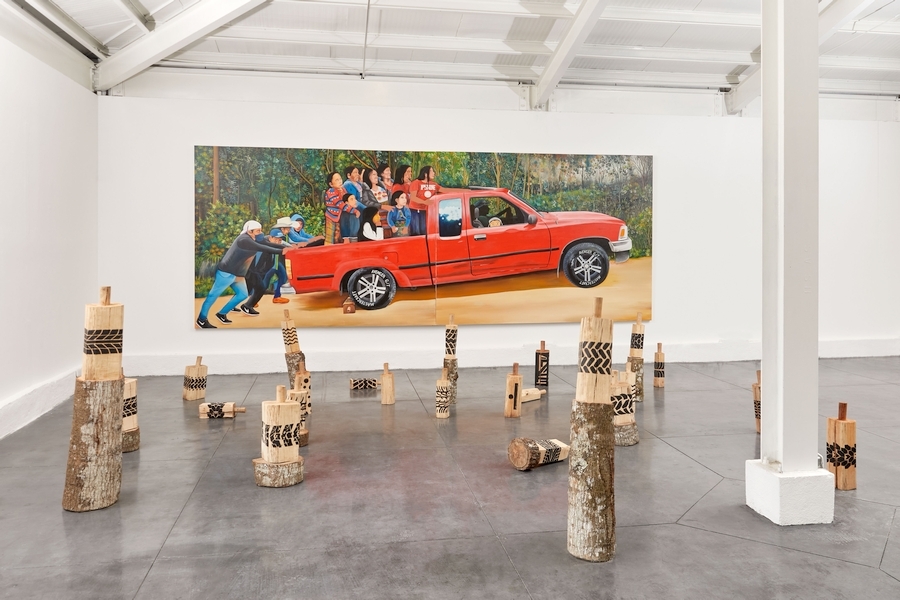
Me dijo despacio: no tengas miedo
[He said to me slowly: don’t be afraid][1]
These roads are made of earth, they foretell the eternal return of our bodies to the greater corpus. And on them, our hearts travel, peregrinos devotos al dolor [pilgrims devoted to pain],[2] traveling through the greatest of pains: the truth.
In Guatemala, the truth is like the night: it covers us. It covers the cities, the sidewalks, the fields. And we, in that desperate eagerness to lie, illuminate ourselves. The night is the fact, the call, the verdict that reminds us that all is over. Yet, desperately, we need to continue. If only death were like that.
We have long been attached to a half-truth. We will probably never fully know it, just as we cannot know the implications of the night. Nor have we understood our own implications around the artificial light we have created. It is also likely that our becoming is always a nuance. The nuance between absolute darkness and the reflection of a made-up light.
The nuances allow contemplation. Because in extremes or totalities, there is only one version of things that is believed or assumed. An unquestionable one. In that contemplation–scarcer every time–away from crushing discourses, it is possible to listen to the voices.
When we are no longer afraid, we are forced to listen to said voices. Those that are always inside our conscience. The ones that whisper at night, the ones that ask for some loose change in the street. The voices that say very well, ma’am or yes, ma’am. Even those that are silent, those that give, because from silence (terrible and lurid) stories are born. They transcend our intention, our enthusiasm, our conviction, they surpass our understanding or that which we learn to understand but do not experience ourselves.
Somos astillas, de árboles caídos, de bosques distintos y de montañas contrarias.
Somos astillas que volaron gracias al viento y se encontraron sin querer bajo el retumbo de un volcán
[We are splinters, from fallen trees, from different forests and opposing mountains.
We are splinters that flew thanks to the wind and met unintentionally under the rumble of a volcano.][3]
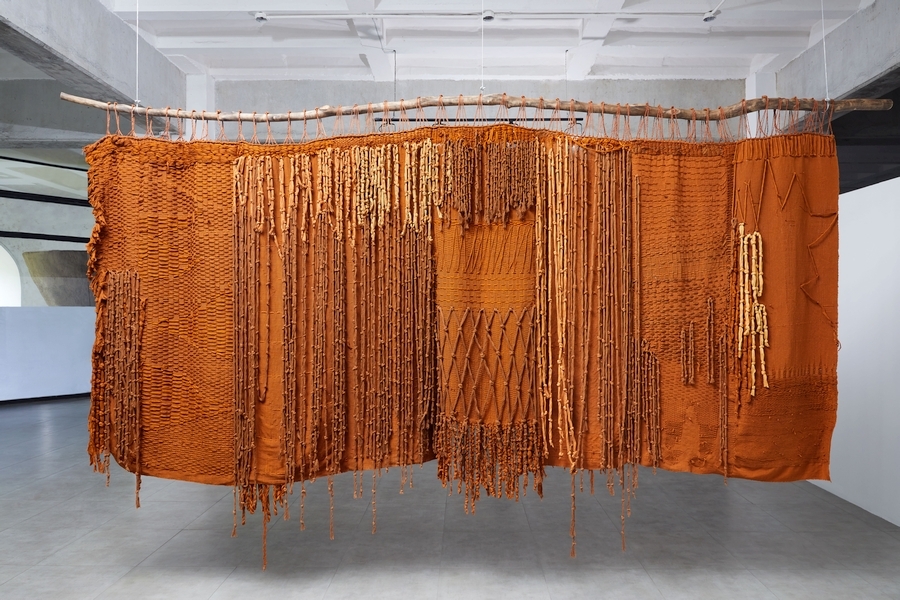
To question ourselves is always a practice of courage. Thus the ancients, those who still live in our communities, say that it’s dangerous to see oneself reflected in the water, because our reflection is a manifestation of the nahual Imox: madness, that which is not known and not fully understood.
The current 22nd edition of the Paiz Art Biennial (BAP), under the curatorship of Alexia Tala and Gabriel Rodríguez Pellecer, offers a scaffolding that has been built over time and experience based on the structure of the Paiz Foundation and the art/theory/action platform that its team has developed over time. I think it is vital to mention this because, in order to maintain this model, it is imperative to know the structures, platforms, and scaffolding that support it and make it work. The curatorial models that have been proposed for the last three editions of the BAP have included educational and engagement programs based on the discourses and artistic practices that stem from the script of each biennial.
There are manifestos, opinions, and theoretical writing, where it is stated that the visual should be forceful, therefore, it should not be explained, as is the case with pictograms or emojis. The visual arts are media that communicate. The contemporary investigative practices of artists and curators have a logical narrative that seeks to evidence, denounce, raise awareness, among other things, about issues that affect certain contexts. In the case of the 22nd BAP, titled Perdidos. En medio. Juntos [Lost. In the middle. Together], the aim is to focus on the capacity of the global south to tell its own stories.
What stories are we allowed to tell and who allows or moderates these narratives? In history, it is the hegemonic groups who decide what story should be told.[4] The tour through the venues of the 22nd BAP offers diverse narrations of events that have traversed the bodies of a large part of the population–including myself, as a part of the K’iche’ nation. Everything that does not go through the body is a pamphlet. What happens with everything that is named but not experienced? Who has given power to these voices? And above all, why is the authority given by someone from the outside?
Perhaps the first point I would like to make is about curatorship. From which instances do the curators speak? Of the broad spectrum of issues addressed in this edition of the biennial, which of them pervade the curators’ bodies?
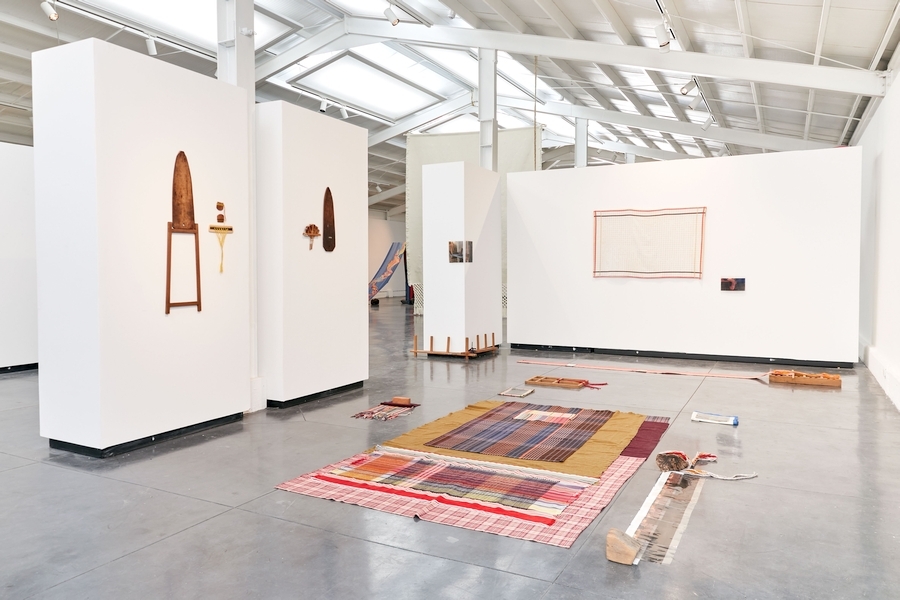
May we speak of a diplomatic curatorship?[5]
There is a relevance around speaking out when we talk about violence and other evils of the territory we inhabit. From what is lived in the communities inhabited by the native peoples, somehow, there is a certain weariness or tiredness of the constant repetition of the British model of exploration of the 18th and 19th centuries, in which others speak for us, tell what we should tell and validate what is naturally already valid in our history. Nor should we lose sight of the fact that curatorship, teaching and the academy are places of power from which this model is displayed and exercised.
In view of this, I think it pertinent to offer a narrative with artists who, in their artistic and research practices and from their own bodies, bear witness to the colonial, systemic and historical violence that emerges as the generating idea of Perdidos. En medio. Juntos.
La conciencia de la piedra/habla desde su centro /dice nuestro nombre/la piedra busca su mano/y nuestra mano busca su piedra/en su centro guarda nuestra suerte/nuestro duro destino/nuestro blando destino/mi piedra y yo nos atravesamos/la lancé unas cuantas veces/regresó fragmentada/lengüeteada por el sol/sudando estaba su corazón/cuando me la tragué a pedacitos/para que no se perdiera
[The stone’s consciousness/speaks from its center/speaks our name/the stone seeks its hand/and our hand seeks its stone/at its center it holds our fate/our hard destiny/our soft destiny/my stone and I cross each other/I cast it a few times/it came back fragmented/licked by the sun/sweating was its heart/when I swallowed it in pieces/so it wouldn’t be lost][6]
Power decides what is told and how. The tour of the three venues in Guatemala City (Antiguo Edificio de Correos, Casa Ibargüen, and CCE/LUX) addresses power, its specters, its violence, and its influence on the life we live today.
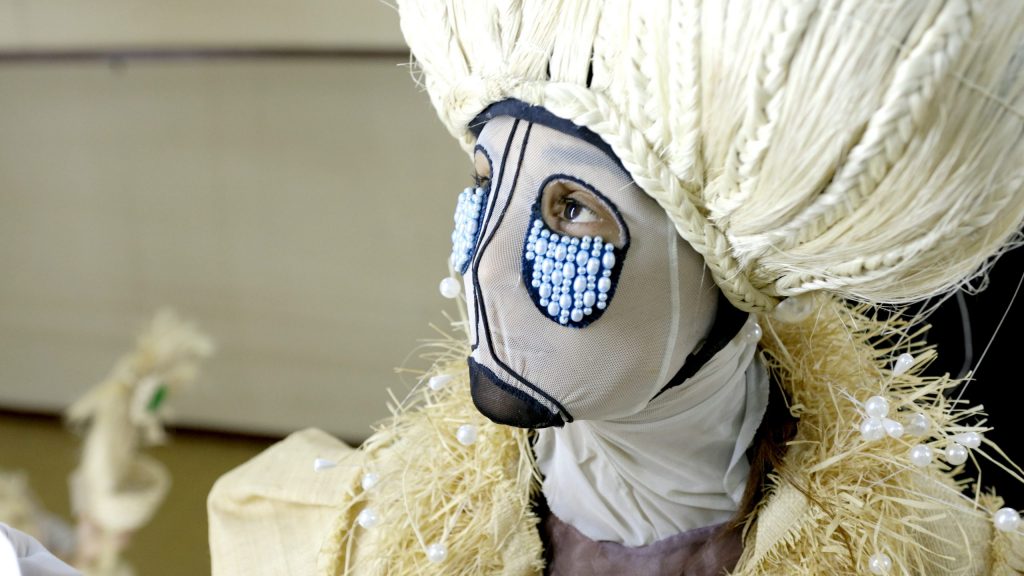
In this understanding, it is imperative to mention those bodies that have been traversed by colonial and structural violence. In this specific group, we look to the works of Marilyn Boror Bor, Diego Isaías Hernández, Óscar Perén and Naufus Ramírez-Figueroa, who prompt gazes and stories departing from their own bodies, communities and experiences about defining events in their lives. Racial discrimination, the systemic violence of the state apparatus (one that is eminently racist), and political persecution are the themes that the aforementioned artists expose in a personal and straightforward manner.
Discursively, in this country, the state apparatus, including the art system and the art market, have excluded these issues. The state promotes an agenda of historical oblivion starting in public and private education. Art, as a system and as a market, validates this agenda by considering that the issues mentioned are not domestic issues and therefore do not deserve to be referenced. To a large extent, this systematization of oblivion is an inheritance that comes from education and artistic knowledge approached solely from an aesthetic-ornamental outlook. However, we know that state power (executive, military, legislative) understands perfectly well the active role of art in the formation and critical/socio-political thinking of the citizens.
Matter: Testimony, plea, claim, and resistance
One of the multiple realities that those of us who make up the Mayan nations and native peoples experience day to day is land. Land as territory or a geographic portion; land as surplus value and land as exploitation. Both the K’iche’ and the Kakchiqel nations, being the two largest in Guatemala (from ancient times to this day) maintain a claim to the land and the notion of what makes up their territory. In a space-time closer to us, too many of us, the having of land has guaranteed us in principle the non-exploitation of our bodies, as well as access to Western academic training and to a large extent, a free and informed opinion.
It is extremely necessary to emphasize this. The plundering of territories of the native peoples has spurred labor exploitation in farms with feudal/latifundist models, little or no access to education, and therefore, submission to the colonialist/slavery models that the electoral democratic system of Latin American nation-states has designed since their very conformation.
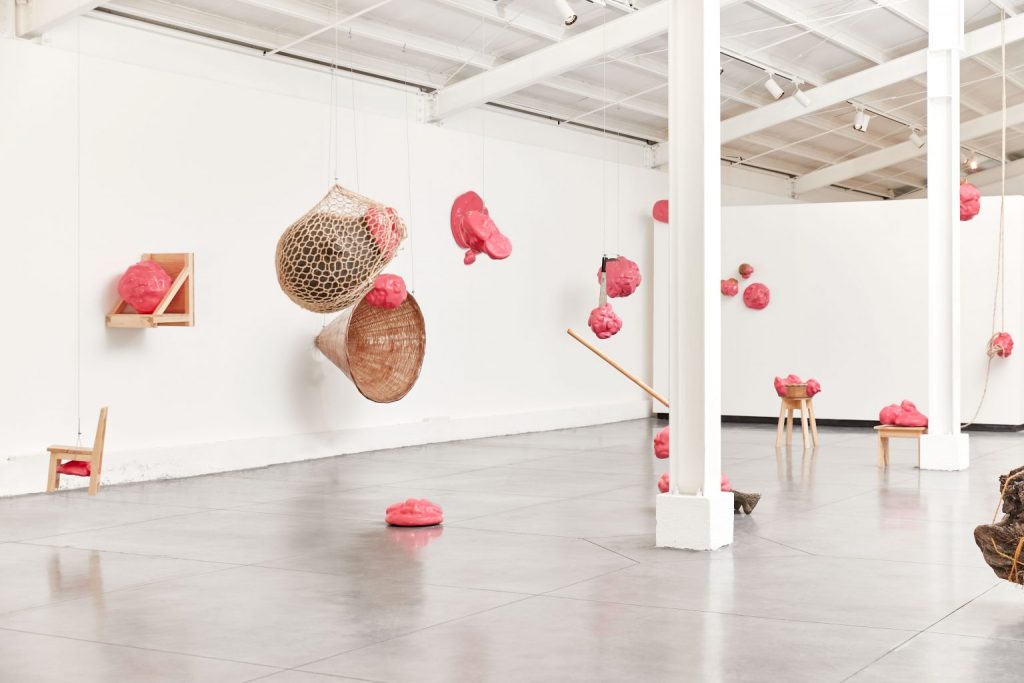
Why matter? Because the entire slave-extractivist model that predominates today in countries such as Guatemala was spawned by it. The artistic practices of Heba Y. Amin, Manuel Chavajay, Edgar Calel, and Antonio José Guzmán exhibit, from the strength of the image and its inseparable relationship with matter, everything that calls us: the land, the water, the community that the artists inhabit and the objects that end up being an extension of our bodies and our stories. The object-based aspect is very important: the clay pot reminds us that one day it was a mountain and that it will return to it. As it also happens with the baskets, the chairs, the nets, the hoes and machetes, and with ourselves, that must all return. What happens then with the plundering that the art system carries out to universalize our particular existence? Is the global south a way of invisibilizing and revealing at the convenience of curatorial power? What is being negotiated in this territorial diplomacy?
Transcending: the memory that burns and remains, the wound and the word
There are wounds that do not heal because they remind us of a passing comet, a hurricane or even an earthquake. Do lakes dry up without memory? Who forgets a sunny day? When do you forget your mother’s eyes? Memory is a constant that is built every day. Memory is woven from the people, from our stories, from our streets–yes, ours–and from our bodies.
What are the wounds and what are our responses? How much have we endured? In their presentation at the CEE/LUX, Paz Errázuriz and Rosa Chávez give an account of this. There is a poetic instant in Paz’s gaze and Rosa’s texts that appeals to the most human dimension, to the ephemeral and at the same time, enduring. The gaze of the women of Sepur Zarco is not one that can be held or dimensioned. It is not an exercise of pain or exoticization. It is an exercise of memory. In our logic of life, we sow the cornfields even with the certainty that the wind can blow them down. That is what our ancestors have done with us. We have on our shoulders the burden of invasion and plunder, but we continue to walk on the face of the earth.
It is convenient and necessary to compare the official narratives of history with those presented in this edition of the biennial. Many of the agents (dissidents and those in resistance) propose a version of history that is not told, neither from training, nor from home, nor from university education, but is preserved from orality, from many expressions that art, as a Western concept, will not be able to understand.

The reading proposed in this text is a vision that comes from the ways of seeing and understanding the world of a cis-gender man who lives and works in a K’iche’ Mayan community in the Guatemalan highlands. I mention this because the stories that the artists mentioned above tell in their works are also part of the history that we have lived and that we have been told in these parts. Evidently, the vision that I propose from my particular point of view, responds to my context and to the privileges that being a man in patriarchal environments implies.
It’s also a response to the questioning of curatorship because it is evident that there are gaps that we have not yet reconciled from the life and understandings of the urban centers, from the urban peripheries, and from the so-called rural life. These conciliations will not happen, in principle, because inequality requires survival actions that neither the academy nor art takes into consideration at a practical level, but as theoretical support for the visibility of the problems, such as those that make up the proposals of this biennial where it is possible to detect cultural appropriations, epistemological extractivism or authors who are the targets of accusations and complaints about violence, harassment, and others.
Because between practice, words, speech, action, and life there is a labyrinth, where the butterfly does not fly and the jaguar does not prey.
La niña
sentada entre sus padres
llora
ante la tragedia
que no comprende
En la pantalla
un hombre de pelo gris
clama porque apaguen
el incendio
¡Son seres humanos!
Grita.
Detrás de él
dos policías susurran:
“no son gente, son indios”
[The child
sitting between her parents
cries
at the tragedy
that she does not understand
On the screen
a gray-haired man
cires out for the fire
to be put out
They are human beings!
He shouts.
Behind him
two policemen whisper:
“they are not people, they are natives”]
Porter – ¿Qué es el amor? – Universal Music México S.A. de C.V., 2018.
Morales Rodríguez, Luis, Niebla Púrpura o nada es importante. Sion Editorial, 2018.
Tax Ajtún, Obdulia Mariela, Poetas de Quetzaltenango, Antología. Sión Editorial, 2021.
Turner Bosso, Gladys. Geografías Perversas, Geografía Maldita, 22nd Symposium of the Paiz Art Biennial, Saturday, May 8, 2021
The implications of diplomacy when curating are the same as in the political practices between states: the legitimization of agents/actions that are not sustained and/or not relevant/appropriate.
Chávez, Rosa. La conciencia de la piedra, 2019.
Comments
There are no coments available.